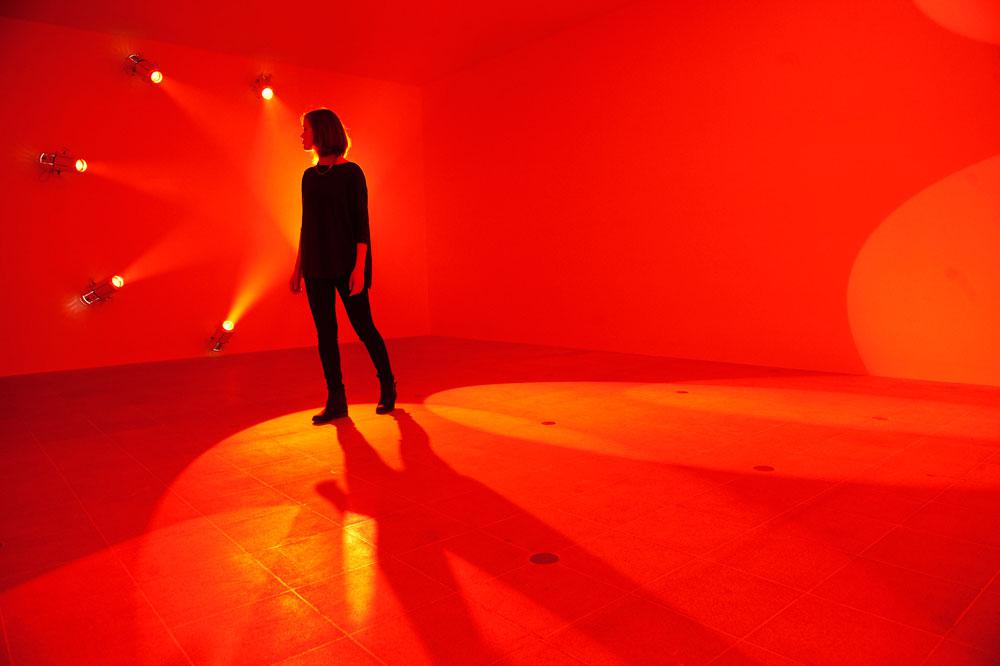Punctuated with multicoloured lightboxes, glowing neon tubes and glittering LEDs, the dark central space of London’s Hayward Gallery currently bears a distinct resemblance to a discotheque. The reason is “Light Show,” an exhibition gathering artworks from the past 50 years that employ light as their primary medium.
The history of light art (if we are to acknowledge it as an independent discipline—it has its own Wikipedia entry, so it must be so) in fact goes back for some time, one notable early electric example being László Moholy-Nagy’s Light-Space Modulator (1930), a large kinetic sculpture incorporating reflection and shadow with typically geometric Bauhaus design.
For this exhibition, however, the Vancouver-raised and UBC-trained Hayward Gallery curator Cliff Lauson chose to focus on art following the “phenomenological turn” of the 1960s, when the experience (and dissolution) of objects in space became paramount, and when artists began to explore in earnest the potential for light as a sculptural material.
Light’s remarkably tangible qualities manifest in works such as Anthony McCall’s You and I, Horizontal (2005), a digital version of the artist’s “solid-light” films of the 1970s. While a projector plays a rudimentary animation, the main interest here is in beams of projected light which pick up a finely dispersed mist, creating the illusion of light as solid form. Viewers may interrupt and shape this pseudo-mass, resulting in an uncannily physical sensation.
The seemingly simple concept of a series of rooms lit up in monochrome red, green and blue in Chromosaturation (1965–2013) by Carlos Cruz-Diez likewise delivers surprising visceral effects by blocking out the colour spectrum—save for in the ambiguous “seams” between rooms.
When preparing to enter enclosed environments by other light-art pioneers Doug Wheeler and James Turrell, however, the act of putting on plastic overshoes and lining up feels as much part of the reverential “experience” as the luminous optical-architectural installations.
The result is anticlimactic. On one hand, there is a novelty in seeing so much light-based art under one roof. On the other, as one might expect, the effect of the individual pieces is sometimes obscured amid so much work from the same genre. Poetically simple sculptures such as Dan Flavin’s no-frills coloured fluorescent tubes and François Morellet’s deconstructed neon tubes lose impact beside some more elaborate installations.
All of the artworks included in “Light Show” use artificial light, but many of the more interesting ones evoke light in nature.
The thousands of LEDs that form Leo Villareal’s Cylinder II (2012) are programmed to sparkle in an infinite array of patterns, suggesting everything from meteor showers to waterfalls.
Holes of Light (1973), a rare indoor installation by Nancy Holt, divides a room with a perforated wall. Through this wall, lights alternately illuminate and cast shadows, conjuring the cycles of sun and moon.
Olafur Eliasson takes this ambiguity a step further with Model for a timeless garden (2011). Here, strobe lights cause a series of water fountains to repeatedly freeze into ethereal shapes reminiscent of glass globules and strings of jewels. The strobe is the epitome of light’s capacity for disorientation.
A very different yet equally bewildering work, Jenny Holzer’s Monument (2008), is a column of electronic signs with text overlapping in a sea of language surrounding the “war on terror.”
Apart from perceptual play, such sculptures share little common ground. The success of “Light Show”—and its failure—lies in demonstrating the tenuousness of the connections between many of its works. If light (like painting or ceramics) stands alone as a medium, perhaps it now offers too broad a category to cohesively tie together an exhibition.









